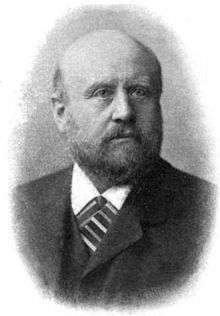Hugo von Seeliger
| Hugo von Seeliger | |
|---|---|
 | |
| Born |
23 September 1849 Bielsko-Biała, Austrian Silesia |
| Died |
2 December 1924 (aged 75) Munich |
| Nationality | German |
| Fields | Astronomy |
| Institutions | University of Munich |
| Alma mater | University of Leipzig |
| Doctoral advisor | Carl Christian Bruhns |
| Doctoral students |
Julius Bauschinger Gustav Herglotz George W. Myers Karl Schwarzschild |
Hugo von Seeliger (23 September 1849 – 2 December 1924), also known as Hugo Hans Ritter von Seeliger, was a German astronomer, often considered the most important astronomer of his day.
He was born in Austrian Silesia, completed high school in Teschen in 1867, and studied at the Universities of Heidelberg and Leipzig. He earned a doctorate in astronomy in 1872 from the latter, studying under Carl Christian Bruhns. He was on the staff of the University of Bonn Observatory until 1877, as an assistant to Friedrich Wilhelm Argelander. In 1874, he directed the German expedition to the Auckland Islands to observe the transit of Venus. In 1881, he became the Director of the Gotha Observatory, and in 1882 became a Professor of Astronomy and Director of the Observatory at the University of Munich, which post he held until his death. His students included Hans Kienle, Ernst Anding, Julius Bauschinger, Paul ten Bruggencate, Gustav Herglotz, Richard Schorr, and especially Karl Schwarzschild, who earned a doctorate under him in 1898, and acknowledged Seeliger's influence in speeches throughout his career.
Seeliger was elected an Associate of the Royal Astronomical Society in 1892, and President of the Astronomische Gesellschaft from 1897 to 1921. He received numerous honours and medals, including knighthood (Ritter), between 1896 and 1917.
His contributions to astronomy include an explanation of the anomalous motion of the perihelion of Mercury (later one of the main tests of general relativity), a theory of nova coming from the collision of a star with a cloud of gas, and his confirmation of James Clerk Maxwell's theories of the composition of the rings of Saturn by studying variations in their albedo. However his main interest was in the stellar statistics of the Bonner Durchmusterung and Bonn section of the Astronomische Gesellschaft star catalogues, and in the conclusions these led about the structure of the universe. Seeliger's views on the dimensions of our galaxy were consistent with Jacobus Kapteyn's later studies.
He continued his work until his death, on 2 December 1924, aged 75.
The asteroid 892 Seeligeria and the lunar crater Seeliger were named in his honour. The brightening of Saturn's rings at opposition is known as the Seeliger Effect, to acknowledge his pioneering research in this field.
Students
His PhD students were (after http://genealogy.math.ndsu.nodak.edu/id.php?id=61848) :
- Julius Bauschinger, Ludwig-Maximilians-Universität München, 1884
- Ernst Anding, Ludwig-Maximilians-Universität München, 1888
- Richard Schorr, Ludwig-Maximilians-Universität München, 1889
- Karl Oertel, Ludwig-Maximilians-Universität München, 1890
- Oscar Hecker, Ludwig-Maximilians-Universität München, 1891
- Adalbert Bock, Ludwig-Maximilians-Universität München, 1892
- George Myers, Ludwig-Maximilians-Universität München, 1896
- Karl Schwarzschild, Ludwig-Maximilians-Universität, München 1897
- Lucian Grabowski, Ludwig-Maximilians-Universität München, 1900
- Gustav Herglotz, Ludwig-Maximilians-Universität München, 1900
- Emil Silbernagel, Ludwig-Maximilians-Universität München, 1905
- Ernst Zapp, Ludwig-Maximilians-Universität München, 1907
- Kasimir Jantzen, Ludwig-Maximilians-Universität München, 1912
- Wilhelm Keil, Ludwig-Maximilians-Universität München, 1918
- Friedrich Burmeister, Ludwig-Maximilians-Universität München, 1919
- Gustav Schnauder, Ludwig-Maximilians-Universität München, 1921
- Walter Sametinger, Ludwig-Maximilians-Universität München, 1924
References
- Freddy Litten:Hugo von Seeliger -- Kurzbiographie Short biography (in German).
- Obituary: Professor Hugo von Seeliger Scan from "The Observatory", Vol. 48, p. 77-77 (1925), presented by Smithsonian/NASA ADS Astronomy Abstract Service
- Hugo von Seeliger at the Mathematics Genealogy Project